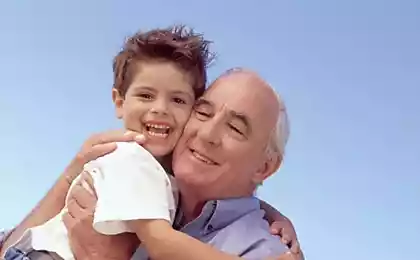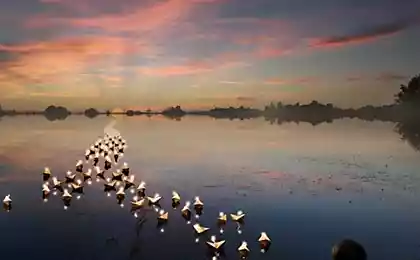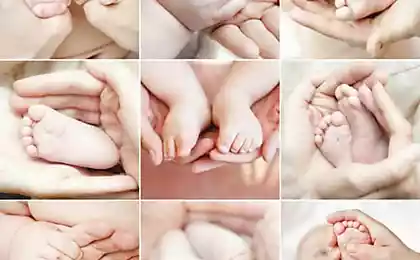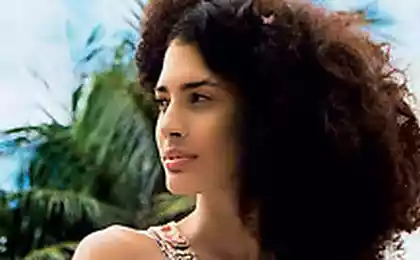684
Weird Science: 8 interesting experiments that will delight every kid!
You are concerned that your child, not knowing what to do at home, sits all day in front of a computer monitor? «What to do? This current generation », i> - you will say. But we have to admit that even in our days, in order to spend time having fun, exciting, and most importantly - useful, does not necessarily have a computer. Take your baby to kink and forth to the kitchen! With the most common available tools that are in the locker each family, you can go with your child all the basics of science. Your offspring of first learns that a chemical reaction, and learn how to carry out small chemical experiments at home. I assure you, your baby will love it! He will like it as much as he loved cartoons and video games. This 8 simple and entertaining experiments, which undoubtedly will appeal to your kids.
1. Coloured Milk
What you will need? Whole milk, dish, food dyes, liquid soap or detergent, cotton swabs.
The course of action. Pour the milk into a bowl, then add a couple of drops of food coloring in different colors. Take a cotton swab, dip it into the liquid soap or detergent. Touch the tip of the rod surface of the milk. You notice how something unimaginable will happen - the milk will begin to move, play and sparkle colors.
How to explain it? The molecules that make up the detergent come with fat molecules that are found in milk, in a chemical reaction, causing the molecules of milk start to move.

2. Dancing coin
What you will need? coins, glass bottle with a narrow neck of water.
The course of action. Put the empty bottle open for a few minutes in the freezer. Then you need to remove the bottle and put on the neck of the vessel coin, before it moistened it with water. In less than a minute later, the coin will begin to "dance", making interesting sounds.
How to explain it? Coin begins to "dance" when exposed to air, which shrank in the freezer and on the change of the temperature began to expand, taking all the larger volume.

3. Lamp lava
What you will need? The water, salt, vegetable oil, food coloring, bank.
The course of action. Fill the jar with water 2/3 now fill the vessel with oil. Then add the dye. Vsyp 1 teaspoon of salt.
How to explain it? If the oil is at the beginning of the experiment was on the surface of the water, because it has a higher density, then under the influence of salt, which is heavier than oil, it drops to the bottom. Food coloring can help you make the phenomenon more visible and spectacular.

4. Volcanoes
What you will need? tray, sand or clay, plastic bottles, food coloring, vinegar, baking soda.
The course of action. are blind with clay or sand volcano. As a form, around which you do modeling, use a plastic bottle. To start the "eruption", a mound in a bottle 2 tablespoons of baking soda, pour 1/4 cup of warm water, a mound of food coloring, then add 1/4 cup of vinegar.
How to explain it? between the molecules of the vinegar and baking soda is an active chemical reaction of water, salt and carbon dioxide, and the gas bubbles are pushed out of the bottle contents.
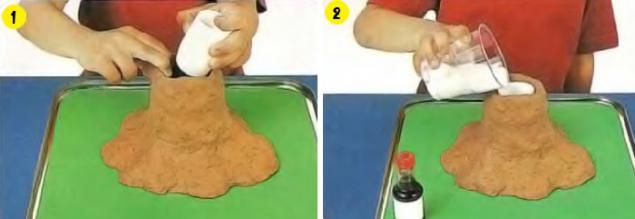
5. Walking on egg
What you will need? 2 dozen eggs in trays, trash bags.
The course of action. cover the floor garbage bags and put them on a tray with 2 eggs. Eggs should be turned sharp or blunt ends to one side. If you put the right foot and evenly distribute the weight, then you are even able to literally walk on the balls without hurting the single. Do not trust? Try it with a toddler!
How to explain it? Despite the apparent fragility, the shell eggs are known to be very durable and can withstand even heavy. With uniform pressure, the stress is distributed over the entire shell, which is why it does not crack.

6. Growing crystals
What you will need? The water, salt, wire or rods, food coloring.
The course of action. Add to the large amounts of salt water to form a thick consistency that when you add a new portion, salt will not be dissolved. Make a small loop on the wire and dip it in the solution. The Bank is in a warm place, so that the liquid is slowly cooled. After a few days you can watch both the wire begins to grow beautiful colored crystals.
How to explain it? When the water begins to cool, salt solubility decreases. It is precipitated and deposited on the walls of the vessel and a wire, respectively.

7. Rainbow at home
What you will need? Deep (preferably transparent) saucer, water, A4 sheet, mirror, flashlight.
The course of action. Pour into a bowl of water and put it on the bottom of the mirror. Shine a flashlight on the mirror. Try to catch the reflected light a piece of paper on which there should be a rainbow.
How to explain it? A beam of light is actually composed of invisible to the naked eye in different colors. When a ray passes through the water, it starts to be decomposed into its component parts in the form of a rainbow.
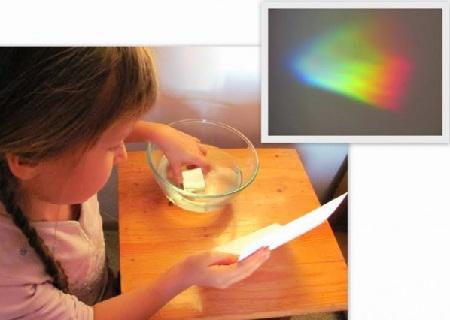
8. The denomination that burns without burning
What you will need? banknotes (as you do not mind), salt, matches, 50% ethyl alcohol, tweezers.
The course of action. The mound in a solution of alcohol a pinch of salt, and then perches in a dollar bill and let it soak in properly. Get the tweezers bill and wait for her to not drain excess fluid. Now set fire bill and watch the interesting spectacle - the money will burn, not burning.
How to explain it? As a result of the burning of the solution of ethyl alcohol and salt form water, carbon dioxide and heat. If you bill be lit, it will burn alcohol solution. The fact that the temperature at which it burns is insufficient to evaporate the water, which is impregnated banknote. As a result, all of the alcohol burns, the flame goes out, and slightly damp bill remains intact.

It turns out that the science is very entertaining. It is necessary to vaccinate the child interest in such serious things in a playful way since childhood. I'd have not given up on these experiments, I imagine how they will be glad your baby! Share these interesting experiments with his friends, who also bred hands, not knowing what to do with their child.
via ofigenno ru
1. Coloured Milk
What you will need? Whole milk, dish, food dyes, liquid soap or detergent, cotton swabs.
The course of action. Pour the milk into a bowl, then add a couple of drops of food coloring in different colors. Take a cotton swab, dip it into the liquid soap or detergent. Touch the tip of the rod surface of the milk. You notice how something unimaginable will happen - the milk will begin to move, play and sparkle colors.
How to explain it? The molecules that make up the detergent come with fat molecules that are found in milk, in a chemical reaction, causing the molecules of milk start to move.

2. Dancing coin
What you will need? coins, glass bottle with a narrow neck of water.
The course of action. Put the empty bottle open for a few minutes in the freezer. Then you need to remove the bottle and put on the neck of the vessel coin, before it moistened it with water. In less than a minute later, the coin will begin to "dance", making interesting sounds.
How to explain it? Coin begins to "dance" when exposed to air, which shrank in the freezer and on the change of the temperature began to expand, taking all the larger volume.

3. Lamp lava
What you will need? The water, salt, vegetable oil, food coloring, bank.
The course of action. Fill the jar with water 2/3 now fill the vessel with oil. Then add the dye. Vsyp 1 teaspoon of salt.
How to explain it? If the oil is at the beginning of the experiment was on the surface of the water, because it has a higher density, then under the influence of salt, which is heavier than oil, it drops to the bottom. Food coloring can help you make the phenomenon more visible and spectacular.

4. Volcanoes
What you will need? tray, sand or clay, plastic bottles, food coloring, vinegar, baking soda.
The course of action. are blind with clay or sand volcano. As a form, around which you do modeling, use a plastic bottle. To start the "eruption", a mound in a bottle 2 tablespoons of baking soda, pour 1/4 cup of warm water, a mound of food coloring, then add 1/4 cup of vinegar.
How to explain it? between the molecules of the vinegar and baking soda is an active chemical reaction of water, salt and carbon dioxide, and the gas bubbles are pushed out of the bottle contents.

5. Walking on egg
What you will need? 2 dozen eggs in trays, trash bags.
The course of action. cover the floor garbage bags and put them on a tray with 2 eggs. Eggs should be turned sharp or blunt ends to one side. If you put the right foot and evenly distribute the weight, then you are even able to literally walk on the balls without hurting the single. Do not trust? Try it with a toddler!
How to explain it? Despite the apparent fragility, the shell eggs are known to be very durable and can withstand even heavy. With uniform pressure, the stress is distributed over the entire shell, which is why it does not crack.

6. Growing crystals
What you will need? The water, salt, wire or rods, food coloring.
The course of action. Add to the large amounts of salt water to form a thick consistency that when you add a new portion, salt will not be dissolved. Make a small loop on the wire and dip it in the solution. The Bank is in a warm place, so that the liquid is slowly cooled. After a few days you can watch both the wire begins to grow beautiful colored crystals.
How to explain it? When the water begins to cool, salt solubility decreases. It is precipitated and deposited on the walls of the vessel and a wire, respectively.

7. Rainbow at home
What you will need? Deep (preferably transparent) saucer, water, A4 sheet, mirror, flashlight.
The course of action. Pour into a bowl of water and put it on the bottom of the mirror. Shine a flashlight on the mirror. Try to catch the reflected light a piece of paper on which there should be a rainbow.
How to explain it? A beam of light is actually composed of invisible to the naked eye in different colors. When a ray passes through the water, it starts to be decomposed into its component parts in the form of a rainbow.

8. The denomination that burns without burning
What you will need? banknotes (as you do not mind), salt, matches, 50% ethyl alcohol, tweezers.
The course of action. The mound in a solution of alcohol a pinch of salt, and then perches in a dollar bill and let it soak in properly. Get the tweezers bill and wait for her to not drain excess fluid. Now set fire bill and watch the interesting spectacle - the money will burn, not burning.
How to explain it? As a result of the burning of the solution of ethyl alcohol and salt form water, carbon dioxide and heat. If you bill be lit, it will burn alcohol solution. The fact that the temperature at which it burns is insufficient to evaporate the water, which is impregnated banknote. As a result, all of the alcohol burns, the flame goes out, and slightly damp bill remains intact.

It turns out that the science is very entertaining. It is necessary to vaccinate the child interest in such serious things in a playful way since childhood. I'd have not given up on these experiments, I imagine how they will be glad your baby! Share these interesting experiments with his friends, who also bred hands, not knowing what to do with their child.
via ofigenno ru
“You just broke your child. Well done! The cry of the soul of a single father blew up the Internet!
This picture was the reason for their divorce! You will be very surprised when you find out why ...






